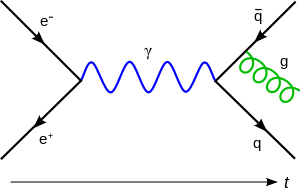Dirac equation in curved spacetime
In mathematical physics, the Dirac equation in curved spacetime generalizes the original Dirac equation to curved space.
| Quantum field theory |
|---|
 |
| History |
|
Background
|
|
|
Scientists
|
It can be written by using vierbein fields and the gravitational spin connection. The vierbein defines a local rest frame, allowing the constant Dirac matrices to act at each spacetime point. In this way, Dirac's equation takes the following form in curved spacetime:[1]
Here eaμ is the vierbein and Dμ is the covariant derivative for fermionic fields, defined as follows
where σab is the commutator of Dirac matrices:
and ωμab are the spin connection components.
Note that here Latin indices denote the "Lorentzian" vierbein labels while Greek indices denote manifold coordinate indices.
See also
References
- Lawrie, Ian D. A Unified Grand Tour of Theoretical Physics.
- M. Arminjon, F. Reifler (2013). "Equivalent forms of Dirac equations in curved spacetimes and generalized de Broglie relations". Brazilian Journal of Physics. 43 (1–2): 64–77. arXiv:1103.3201. Bibcode:2013BrJPh..43...64A. doi:10.1007/s13538-012-0111-0.
- M.D. Pollock (2010). "on the dirac equation in curved space-time". Acta Physica Polonica B. 41 (8): 1827.
- J.V. Dongen (2010). Einstein's Unification. Cambridge University Press. p. 117. ISBN 0-521-883-466.
- L. Parker, D. Toms (2009). Quantum Field Theory in Curved Spacetime: Quantized Fields and Gravity. Cambridge University Press. p. 227. ISBN 0-521-877-873.
- S.A. Fulling (1989). Aspects of Quantum Field Theory in Curved Spacetime. Cambridge University Press. ISBN 0-521-377-684.
This article is issued from Wikipedia. The text is licensed under Creative Commons - Attribution - Sharealike. Additional terms may apply for the media files.